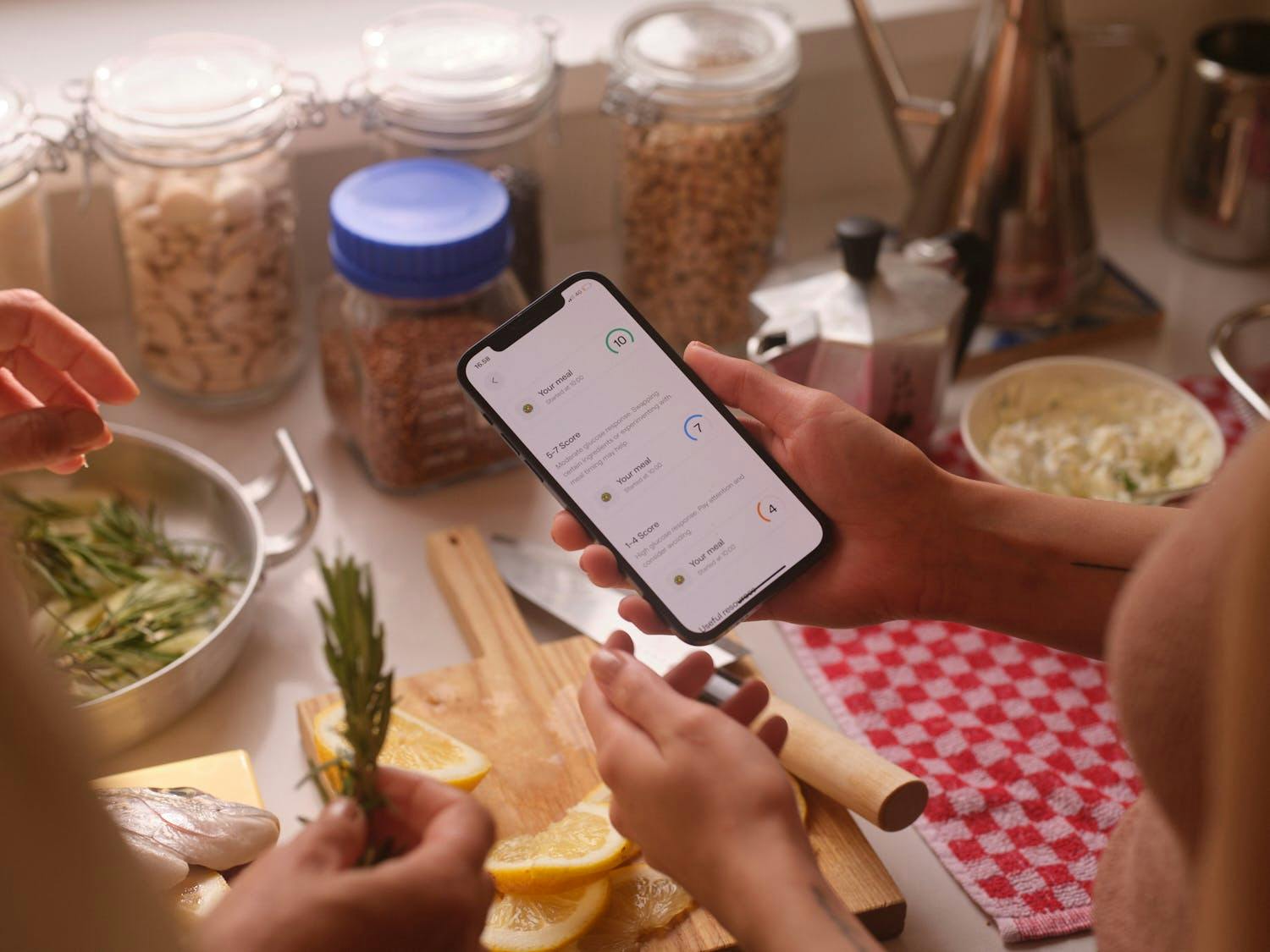Not all carbohydrates are created equal. In recipes, the “sugar” ingredient listed is actually sucrose, a compound that’s comprised of fructose and glucose. Though these three kinds of sugars taste similar on the tongue, your body processes them in vastly different ways — leading to a range of unique effects on your hormones, metabolism, and appetite, among other things.
What is glucose?
Glucose (C6H12O6) is a simple sugar that’s also known as “blood sugar.” It’s a monosaccharide (i.e., single saccharide), which means that it can’t be broken down into smaller molecules.
Glucose is the body's preferred source of energy and is essential to life — you quite literally can’t live without it. Your body primarily uses glucose in two ways:
- Glucose is the most efficient way for your body to produce adenosine triphosphate (also known as ATP), which is like a tiny rechargeable battery inside your cells.
- Glucose is used to maintain the structure of cells themselves, which keeps many life-sustaining chemical reactions running smoothly.
You can get glucose naturally from a number of foods that are probably already in your diet, ranging from whole grains, nuts, fruits, and vegetables to starchier options such as bread, white rice, and potatoes.
When you eat these foods, your body will start to break them down into glucose to use as immediate energy or store for later use. To help manage the process and regulate glucose levels, your pancreas will begin to produce the hormone insulin once glucose has entered the bloodstream [1].
You can think of insulin as the “key” that unlocks cells so that glucose in the bloodstream can enter and be converted into energy for essential functions of the body.
This is critical because high glucose levels in the blood can lead to chronic health issues such as heart disease if left unchecked [2]. It may also lead to insulin resistance, a condition shared by 40% of non-diabetic Americans in which a person’s cells stop responding properly to insulin, leading to elevated glucose levels in the bloodstream.
Glycemic index
Foods rich in glucose all fall somewhere on the glycemic index, which classifies foods based on the total number of carbohydrates and their impact on your blood sugar levels. In general, you want to consume more foods that are low on the glycemic index, which are less likely to trigger a spike. When eating foods that are high on the glycemic index, be sure to simultaneously consume proteins and fats to slow down the digestion of carbs.
What is fructose?
Fructose (C6H12O6) is a simple sugar that’s found naturally in many plants. Like glucose, it’s a monosaccharide.
Fructose is often a negative word when people today talk about health, but this sugar is perfectly healthy if eaten in the right forms. Fruits such as apples, cherries, and figs naturally contain a high amount of fructose, and when you enjoy whole fruits like these, there’s no need to fret — the fiber and water content in whole foods slows the release of sugar into your bloodstream [3]. (Another tip is to eat fruits with a fat such as peanut butter.)
It’s when fructose is an added sugar that it becomes a problem — and is considered by many scientists and doctors to be a key contributor to escalating obesity rates and our current metabolic health crisis [4].
In the 1970s, taxes on sugar imports and subsidies on domestic corn made high-fructose corn syrup (or HFCS) — the result of processing corn syrup (which consists of 100% glucose) so that it becomes a blend of 55% fructose and 45% glucose — a much cheaper alternative to table sugar [5, 6]. In addition to being more economical, fructose tastes good: it’s about 1.73 times sweeter than sucrose, meaning that manufacturers can use less of it to achieve the same desired sweetness [7].
To reiterate: there’s an enormous difference between eating an apple and drinking a soda.
The fructose in foods and beverages is an added sugar, typically in the form of HFCS. Excessive consumption of added sugar, whether it’s HFCS or table sugar, may lead to long-term health consequences, including weight gain, fatty liver disease, and uric acid build-up (where uric acid, a waste byproduct of fructose processing that your body typically flushes out in urine, ends up lingering in the body, depositing in the joints, and causing gout) [8, 9].
How fructose is metabolized
Your body gets energy from the foods you eat — and one such source of energy is fructose.
Like glucose (our body’s main source of energy), fructose is absorbed directly into the bloodstream during digestion. Unlike glucose, it must be metabolized in the liver and converted into glucose so your body can use it [10].
When fructose was first popularized in HFCS and agave, it was touted as a “healthier” alternative to table sugar because it’s much slower to spike your blood sugar and doesn’t appear to raise your insulin.
However, later research has indicated that excessive consumption of fructose is, in some ways, worse — it can lead to insulin resistance, which prevents you from losing weight, and can overwhelm your liver and cause fatty liver disease [11]. It may also raise bad cholesterol in the body and have a negative impact on cardiovascular health [12].
Compared to glucose, fructose also tends to be a worse appetite suppressant and can actually lead to increased hunger and desire for food [13].
What is sucrose?
Sucrose, or table sugar, is derived from sugar cane or sugar beets. Specifically, sucrose is made up of 50% fructose and 50% glucose.
As a disaccharide, sucrose must be broken down into parts by enzymes before your body can use it, a normal digestive process that primarily occurs in the small intestine. The caveat is that since your body produces insulin in response to glucose processing, a bit of fructose uptake occurs as well.
In other words, after your body is done using glucose as energy, the extra fructose that was absorbed into your bloodstream goes straight into your fat deposits — which can make you gain weight and lead to health complications [14, 15].
Takeaways: fructose vs. glucose vs. sucrose
The bottom line? You should try to avoid added sugars as much as possible, but don’t hold yourself back from enjoying whole grains, fruits, and vegetables, which contain the carbohydrates (i.e., energy) your body needs to support key metabolic processes.
Meal prep tips
As you’re preparing your meals this week, load up your plate with an array of colorful produce (which contain antioxidants that keep your body feeling young) and aim for a balance of nutrients during each meal, including carbohydrates, proteins, and fats — all of which can help slow down the absorption of sugar into your bloodstream and prevent a spike.
Things to avoid at the grocery store
Keep an eye out for added fructose or sugar in the snacks, beverages, and prepared foods you buy during your next trip to the grocery store.
As a rule of thumb, it’s smart to stick to the edges of the store (where all the fresh fruit and vegetables are located) to help you steer clear of HFCS and other ingredients you might want to avoid. But in a pinch, scan ingredient labels for the following words, which are all high-fructose corn syrup disguised under alternative names:
- Glucose syrup
- Corn syrup
- Isoglucose
- Tapioca syrup
- Crystalline fructose
Remember, dietary labels such as gluten-free, vegan, Paleo, and more don’t necessarily mean low-sugar or “healthy” — you’ll feel more in control of your own health once you look past the marketing language and study the actual ingredients and nutrition labels.
References:
- https://www.ncbi.nlm.nih.gov/pmc/articles/PMC4892884/
- https://jamanetwork.com/journals/jamainternalmedicine/article-abstract/217549
- https://www.sciencedirect.com/topics/agricultural-and-biological-sciences/fructose
- https://pubmed.ncbi.nlm.nih.gov/22297952/
- https://www.britannica.com/video/186965/differences-sugar-corn-syrup
- https://www.fda.gov/food/food-additives-petitions/high-fructose-corn-syrup-questions-and-answers
- https://www.worldofmolecules.com/3D/what-is-the-difference-between-sucrose-and-fructose.html
- https://pubmed.ncbi.nlm.nih.gov/15983189/
- https://pubmed.ncbi.nlm.nih.gov/17190309/
- https://www.sciencedirect.com/topics/medicine-and-dentistry/fructose-metabolism
- https://pubmed.ncbi.nlm.nih.gov/15983189/
- https://www.ncbi.nlm.nih.gov/pmc/articles/PMC2673878/
- https://www.ncbi.nlm.nih.gov/pmc/articles/PMC4443321
- https://pubmed.ncbi.nlm.nih.gov/25100436/
- https://www.ncbi.nlm.nih.gov/pmc/articles/PMC5409744/


